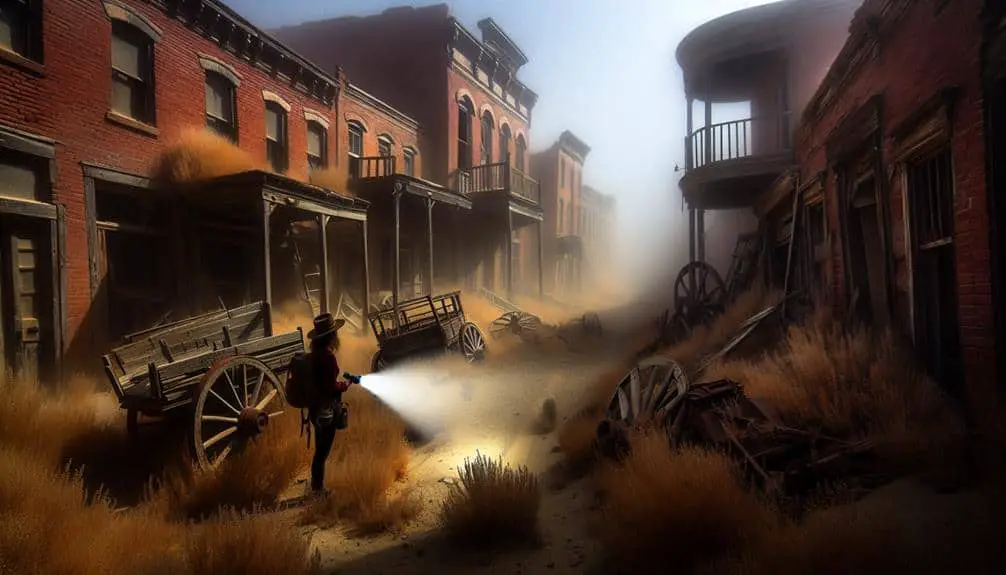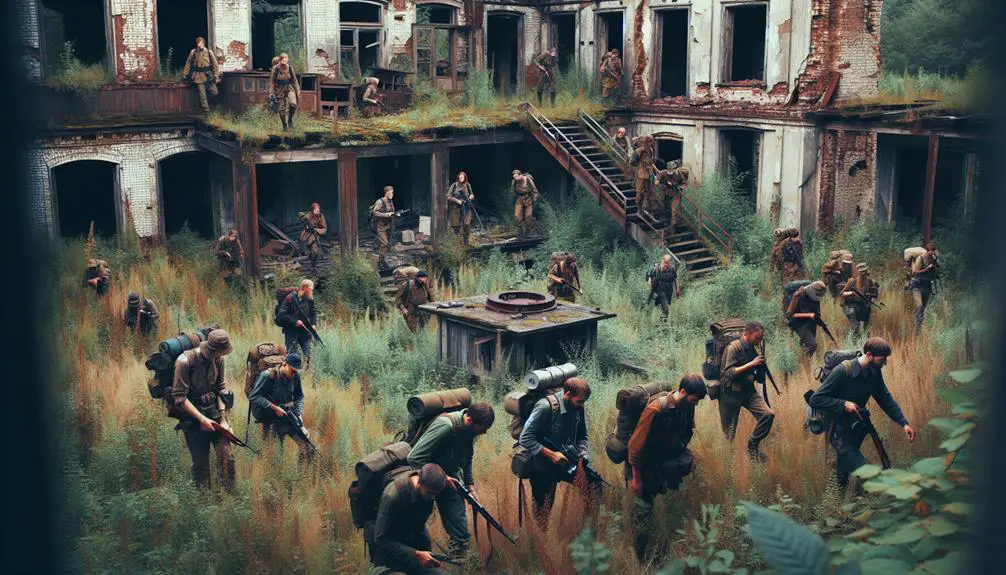Explore Civil War ghost towns to uncover historical secrets. Preservation efforts maintain importance and haunted legends add intrigue. Factors like economic decline and infrastructure decay contribute to abandonment. Notable towns like Bodie and Shiloh offer unique insights into history. When exploring, prioritize safety and respect, research potential hazards, and come prepared. Restoration efforts are essential for preserving historical integrity. By understanding the past, you can connect with history in a meaningful way. Discover more about exploring and preserving these historical treasures for a deeper appreciation of American heritage.
Key Points
- Research historical significance before exploring.
- Prioritize safety and respect for preservation efforts.
- Be prepared for potential hazards and wear appropriate attire.
- Engage with the community to enrich restoration efforts.
- Document findings for historical records and site revival.
Overview of Civil War Ghost Towns
Explore the fascinating history and significance of Civil War ghost towns that offer a glimpse into a pivotal era of American history. Preservation efforts play a vital role in maintaining these towns, ensuring their historical significance isn't lost to time. Many of these towns have become the subjects of haunted legends and stories of paranormal activity, adding an air of mystery and intrigue to their already rich history.
Preservation efforts focus on maintaining the authenticity of these towns, allowing visitors to experience a snapshot of life during the Civil War era. The historical significance of these ghost towns lies in their ability to transport visitors back in time, offering a tangible connection to the past. Through careful restoration and conservation, these towns serve as living museums, preserving the stories and memories of those who once called them home.
Haunted legends and tales of paranormal activity add another layer of intrigue to these ghost towns, drawing in visitors curious about the supernatural. Whether these stories are based on actual events or are products of imagination, they contribute to the mystique surrounding these abandoned settlements.
Factors Contributing to Abandonment
Factors contributing to the abandonment of Civil War ghost towns vary from economic decline to natural disasters, each playing a significant role in the desolation of these once-thriving communities. Economic instability was a common factor leading to the abandonment of Civil War-era towns. Industries that once sustained these towns collapsed, leaving residents without livelihoods. The decline in economic opportunities forced people to seek better prospects elsewhere, gradually emptying these settlements.
Infrastructure decay also played an essential role in the abandonment of Civil War ghost towns. As roads, bridges, and buildings deteriorated over time, the cost of maintenance became unsustainable for the dwindling population. With limited resources and a lack of investment in infrastructure, these towns became increasingly isolated and inhospitable. This combination of economic instability and infrastructure decay created a cycle of decline that ultimately led to the abandonment of these once bustling communities. Understanding these factors can provide valuable insight into the history and fate of Civil War ghost towns.
Notable Civil War-Era Ghost Towns
Several notable Civil War-era ghost towns stand as poignant reminders of a bygone era, each with its own unique story of abandonment and desolation.
One such town is Bodie, California, known for its well-preserved buildings and eerie atmosphere. Bodie's haunted legends add to its mystique, drawing visitors intrigued by the supernatural.
Another ghost town of historical significance is Shiloh, Tennessee, where a major Civil War battle took place, leaving behind ruins and a somber aura. Shiloh's abandoned structures serve as a stark reminder of the brutality of war.
Additionally, Centralia, Pennsylvania, stands out for its underground mine fire that has been burning since 1962, forcing residents to evacuate and leaving behind a ghostly landscape.
These ghost towns not only offer a glimpse into the past but also spark curiosity with their haunting tales and historical importance. Exploring these sites provides a unique opportunity to connect with history and reflect on the impact of war on communities.
Tips for Exploring Forgotten Communities
For a comprehensive and enriching experience when delving into forgotten communities, consider planning your exploration with careful attention to historical significance and safety measures. Exploring these hidden gems can be both exciting and educational, but it's crucial to prioritize safety and respect for the historical importance of these sites.
When setting out on your journey to discover forgotten communities, make sure to research the area beforehand. Understanding the historical significance of the town you're about to explore can deepen your appreciation for its past and enhance your overall experience. Look into any potential safety hazards in the area such as unstable structures, wildlife, or environmental risks, and prepare accordingly.
While exploring, always give priority to your safety by wearing appropriate footwear and clothing, staying hydrated, and informing someone of your whereabouts. Respect the historical significance of the site by refraining from removing any artifacts or damaging any structures. By approaching your exploration with a blend of curiosity, caution, and reverence for history, you can make the most of your journey into these forgotten communities.
Preserving History: Restoring Ghost Towns
When considering the preservation of ghost towns, one must acknowledge the critical role restoration plays in safeguarding historical integrity and cultural heritage. Preservation methods for ghost towns involve a delicate balance between maintaining authenticity and guaranteeing structural stability. One common approach is stabilization, where the priority is to prevent further decay and collapse of buildings. This often includes structural reinforcement and weatherproofing to protect against the elements.
Community engagement is another essential aspect of preserving ghost towns. Involving local residents, historians, and preservation experts can bring diverse perspectives and insights that enrich the restoration process. Collaborative efforts ensure that the town's history is accurately represented and that the restoration aligns with community values and goals.
Moreover, documenting the restoration process through photographs, videos, and written accounts can serve as valuable historical records for future generations. By employing these preservation methods and fostering community engagement, ghost towns can be revived as living historical sites that honor the past while contributing to the cultural landscape of the present.
Frequently Asked Questions
Are There Any Safety Precautions to Keep in Mind When Exploring Civil War Ghost Towns?
When exploring Civil War ghost towns, always prioritize safety by wearing sturdy shoes, bringing water, and being aware of unstable structures. Respect the historical significance of these sites, support preservation efforts, and use proper exploration techniques.
How Can One Differentiate Between a Regular Abandoned Town and a Civil War-Era Ghost Town?
To differentiate between a regular abandoned town and a Civil War-era ghost town, pay attention to historical significance and preservation efforts. Look for architectural clues and signs of past military presence to identify these unique places accurately.
Are There Any Specific Tools or Equipment Recommended for Exploring Civil War Ghost Towns?
When exploring civil war ghost towns, you'll need essential tools like metal detectors to uncover hidden treasures and flashlights to navigate dark spaces. These items are vital for discovering the secrets these haunted places hold.
What Are Some Common Myths or Misconceptions About Civil War Ghost Towns?
Common myths about Civil War ghost towns include exaggerated haunted stories and historical inaccuracies. Many believe preservation efforts are lacking, but ghostly encounters are rare. Separating fact from fiction is essential for understanding these towns.
Is It Legal to Collect Artifacts or Souvenirs From Civil War Ghost Towns?
Yes, it is illegal to collect artifacts or souvenirs from Civil War ghost towns. Doing so raises ethical considerations about historical preservation, cultural significance, and the potential archaeological impact. Respecting these sites helps protect their integrity for future generations.



